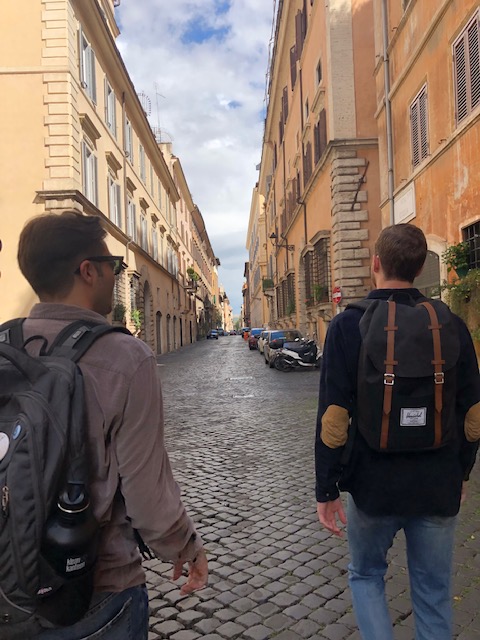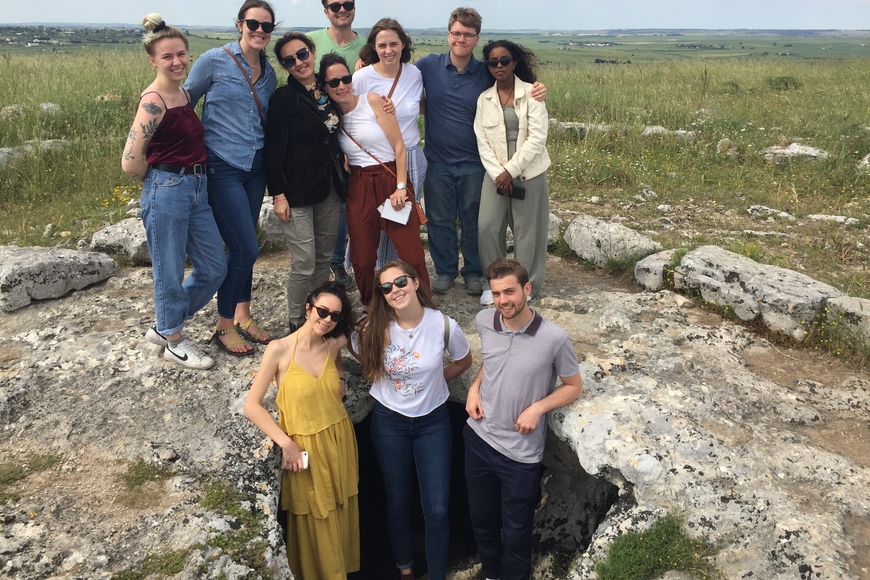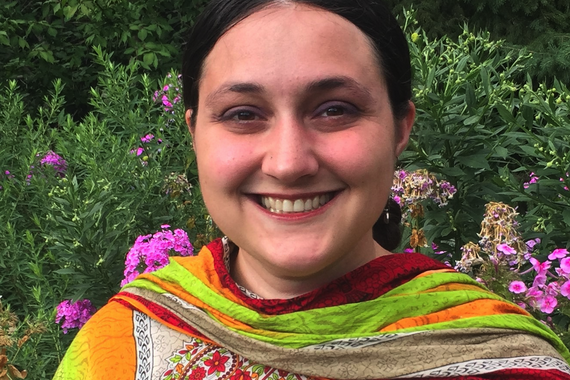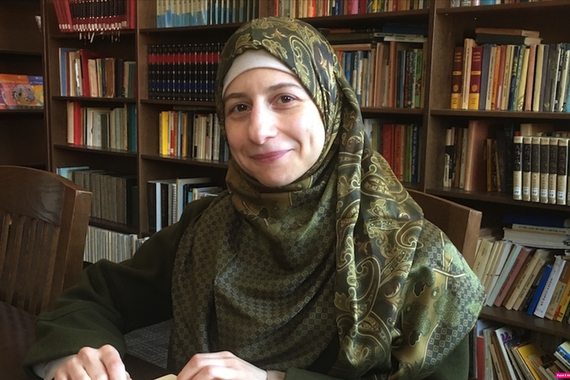Profile Awesome: Kathy Rider “Urban Transformation in Italy” ITAL 3647
Over May term of 2019, the Second Year Italian Coordinator, Kathy Rider, brought nine students to Italy for “Urban Transformation in Italy” ITAL 3647. Kathy Rider clearly adores teaching this course, as it was the third time she has done so and she had nothing but wonderful things to say about the course and, especially, the students.
Tourism, Immigration, and Gentrification

As they traveled and studied in both Minneapolis and Italy, students applied the D.I.E. or the “Describe, Interpret, Evaluate” unit of analysis while considering the agents of change in the neighborhoods they visited. Having practiced this approach throughout the Minneapolis city proper, coming to Rome tested students’ analytic abilities extended to a new context. Starting their learning in Minneapolis, ITAL 3647 students soon spent 3 weeks in Italy with Rome as their “home base.” The whole course centered on forces that have impacted change in urban areas, with the main agents of change being tourism, immigration, and gentrification.
Rider pointed out that the D.I.E. framework is actually much more challenging than it seems because “People don’t realize they’re actually judging before they have even described something. They are not able to accept anything on its own terms and are already filtering whatever it may be automatically. It’s really important that we practice this because it’s a really difficult skill to master. Even something as simple as the word “dirty” is an evaluation (and it does come up in Rome, for better or worse!). I had one experience where I had to keep saying ‘you need to actually describe what you saw, what made it dirty to you. Was it actual dirt or graffiti or what? You have to be specific and withhold assessing.”
How can we unpack things and receive Rome on its own terms, instead of applying this Minneapolis filter to a European capital city, and Rome in particular, which is literally unique?
When in Rome
Another integral framework of the course was that of “Rome Goggles,” a term introduced by their first neighborhood informant, Ferro. “Rome Goggles” refers to the act of “switching your frame of reference; you are now in a European city, a capital European city, a city that has existed in a way you probably can’t fathom as a person coming from the United States.” Resonating deeply with students, the concept of “Rome Goggles” did help students to shift their perspectives and start beginning to engage with Rome as a text with which to interact.
Throughout the course, ITAL 3647 students posted reflections and images on the website https://urbantransformationinitaly.home.blog/ that was published as part of the course. In addition, students’ academic journals were one part of Rider’s favorite aspects of the course because she was able to encourage students to construct their journals in a way that made sense for them--drawing sites for artists, observations of human activity for anthropology and sociology students, focus on economic factors for students of business, etc.
Calling many of the lectures “brainstorming sessions,” Rider highlighted the inherently collaborative nature of this course, adding that the way she designs the course relies on the fact that “Students already come as experts in one field or more. I always have students in the group that know much more than I do about a lot of topics. And so they’re invited to contribute their input regularly, and I need them to.”
Space and Place in Italy
In Rider’s course, Rome is home base.
“You can’t go there without it getting under your skin because of the way that we’re doing it. We live in apartments in the center of Rome, and we are using public transportation to get around. I’m trying to replicate the situation of being a Roman as closely as possible in a very short amount of time, and having the students confront as much as possible as a person living in Rome would. We’re moving around the city as a Roman and doing as much as we can.”
While attempting to see as Romans do, students also maintained their focus on the core course questions of “Who has the right to this place? Who has access to it? Who is this built for? And who is benefiting from it?” Nuance was also crucial; Rider pointed out a course goal as, “We have to see nuance; we have to be able to recognize that two things can be true at the same time and so often are. It’s rarely ever this or that.”

Other places students traveled included Matera, the European Capital of Culture for the year 2019. A UNESCO World Heritage site for its irrigation system, Matera also boasts caves that have been lived in and abandoned continually since pre-history. However, being named the European Capital of Culture has a very real downside---increased tourism. Rider pointed out that “Materans fear they could lose their authentic culture due to a tourism boom. Everything could become mass produced and marketed. The people who actually need this, the community, may not benefit anymore. With the increased tourism, it may be taken out of their hands and they could risk the fate of Alberobello, a Disneyfied place with very little remaining in the way of ‘authentic’. “
An impromptu trip also found the students in Cisternino, a neighboring town. “Barbara Fidanza, our neighborhood informant, and her brother Jacobo (who also joined us, along with her mother, father, and boyfriend), were very concerned that the students would come away without a true idea of Puglia and since they were having a local patron saint festival in the adjacent town, we all loaded up into our van and trekked over to take it in. I’m sure we were the only non-residents in Cisternino that evening, but we were welcomed, included, and treated so warmly.”
“Then we go home to Rome, and everybody feels like they go home; I really like watching them realize they can navigate Rome now, even in such a brief period of time and that they seem to have a feeling of recognition with the city. It’s only been a week and a half and they know where they live and can navigate there. They have that sense of home already.”
Advice to Students and Reflections
While the course is essentially a full semester course taught in three weeks, Rider says that instead of focusing on teaching the students as they are, she is also “teaching the 40 year olds that they will be someday, because you’re going to be thinking about this when you’re 30, 40, 50… probably forever. Don’t think that you’re going to be able to process all this while you’re in the host country. It’s too much, there’s been too much input. If you think you’re going to remember something, write it down because you’re probably not going to. I call this experience a ‘dog-year’ class because it’s more like seven years of class packed into one three-week seminar.”
"It really is a kind of self-discovery course masquerading as a global seminar, because everyone discovers so much about who they are during this trip.”
Final Thoughts
While Rome may be ancient, it is ever evolving, and so is the course. About her five years teaching this course Rider said "Every time it's different; every time it's just freakishly unique, where I can't even say I'm teaching the same course. Just the skeleton is the same. The same guides, the same neighborhood...but things change between when we were there last and when we're there now." Indeed, the only constant we can be sure of is change. Everything changes. Why not cities and neighborhoods, too?
Rider hopes the lasting impact of the course is that “it enriches [students’] lives afterwards because I always want them to appreciate pure description, nuance, withholding evaluation and accepting something or someone on their own terms.”
In constant wonder of her students, Rider said “it’s amazing that it can happen. I’m always impressed and astounded that they rise to the occasion--because they do it with such panache. It’s amazing. They’ve done it and they continue to keep in touch, letting me know how the course continues to impact their lives.”
One student, who asked to not be named, wrote in a card to Rider:
“The way you teach and the passion you exude is so inspiring and magnetic. I am such a different person because of that class and I will be an advocate for it for the rest of my life.”


